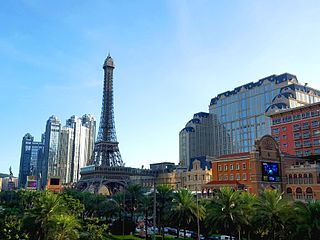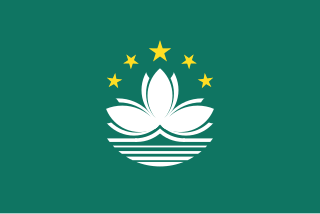Contents
| |||||
| Decades: | |||||
|---|---|---|---|---|---|
| See also: | Other events of 2003 History of Macau | ||||
| |||||
| Decades: | |||||
|---|---|---|---|---|---|
| See also: | Other events of 2003 History of Macau | ||||

Macau is a Special Administrative Region on the southern coast of China. It is located at the south of Guangdong Province, on the tip of the peninsula formed by the Zhujiang estuary on the east and the Xijiang on the west. Macau is situated 60 km (37 mi) west of Hong Kong, and 145 km (90 mi) southwest of Guangzhou, the capital of Guangdong Province. It is situated immediately east and south of Zhuhai.

Macau International Airport is an international airport in the special administrative region of Macau, situated at the eastern end of Taipa island and neighbouring waters. It opened for commercial operations on 9 November 1995, during Portuguese administration of the region.

Taipa is an area in Macau, connected to Coloane through the area known as Cotai, which is largely built from reclaimed land. Located on the northern half of the island, Taipa's population is mostly suburban. Administratively, the boundaries of the traditional civil parish Freguesia de Nossa Senhora do Carmo are mostly coterminous with that of the former Taipa Island, except for a portion of the parish that lies on the island of Hengqin (Montanha), housing the campus of the University of Macau.

Coloane is the southernmost area in Macau, connected to Taipa through the area known as Cotai, which is largely built from reclaimed land. Known as “Lou Wan” in Cantonese, Coloane forms the southern part of Macau. Its population consists of several settlements dotted around the parish, such as Vila de Coloane, Hac Sa, Ká-Hó, and Cheoc Van. Administratively, the boundaries of the traditional civil parish of São Francisco Xavier are coterminous with that of Coloane.

Tourism is a major industry in Macau. It is famous for the blend of Portuguese and Chinese cultures and its gambling industry, which includes Casino Lisboa, Macau, Sands Macau, The Venetian Macao, and Wynn Macau.

Cotai is a 5.2-square-kilometer (2.0 sq mi) piece of reclaimed land on the top of the Seac Pai Bay between Taipa and Coloane islands in Macau that has connected two independent islands since 2005. The name, which is a portmanteau of Coloane and Taipa, can also refer to the island formed by the reclamation. In the second sense, the Special Administrative Region of Macau now consists of the Macau Peninsula, plus Cotai Island, about a mile to the south.

The Fire Services Bureau is responsible for fire and rescue services in Macau. Volunteer fire brigades in Macau dates back to 1851 and full-time department in 1883. Prior to 1851, the Portuguese military provided fire services in the colony. In 1999, the CB became a fully civilian agency. Today the department is organized under the Macau Security Force. The brigade is responsible for fire and rescue for both land and air.

The following outline is provided as an overview of and topical guide to Macau:

Alto de Coloane is the highest point of Macau. The 172.4 m-tall (566 ft) mountain is located on the island of Coloane.

The Correctional Services Bureau is the agency responsible for maintaining inmates in Macau. It is under the administration of the Secretariat for Security.

Companhia de Electricidade de Macau – CEM, S.A. known simply as CEM or Chinese: 澳電 is a private public utility company with a sole concession to transmit, distribute, sell high, medium and low voltage of electricity in Macau. Besides, CEM owns an installed generation capacity of 408 MW.

The Coloane A Power Station is a low-speed diesel-fired power station in Coloane, Macau, China. With an installed capacity of 271.4 MW, it is the largest power station in Macau.

The Coloane B Power Station is a combined cycle gas-fired power station in Coloane, Macau, China. It is the latest power station in Macau.

The electricity sector in Macau ranges from generation, transmission, distribution and sales of electricity in Macau, China.
Events from the year 2010 in Macau, China.

The Museum of Taipa and Coloane History is a museum in Taipa, Macau, China.

The Tam Kung Temple is a temple in Coloane, Macau, China. It is dedicated to Tam Kung.